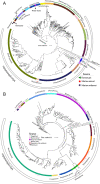Phylogenomics of expanding uncultured environmental Tenericutes provides insights into their pathogenicity and evolutionary relationship with Bacilli
- PMID: 32552739
- PMCID: PMC7301438
- DOI: 10.1186/s12864-020-06807-4
Phylogenomics of expanding uncultured environmental Tenericutes provides insights into their pathogenicity and evolutionary relationship with Bacilli
Abstract
Background: The metabolic capacity, stress response and evolution of uncultured environmental Tenericutes have remained elusive, since previous studies have been largely focused on pathogenic species. In this study, we expanded analyses on Tenericutes lineages that inhabit various environments using a collection of 840 genomes.
Results: Several environmental lineages were discovered inhabiting the human gut, ground water, bioreactors and hypersaline lake and spanning the Haloplasmatales and Mycoplasmatales orders. A phylogenomics analysis of Bacilli and Tenericutes genomes revealed that some uncultured Tenericutes are affiliated with novel clades in Bacilli, such as RF39, RFN20 and ML615. Erysipelotrichales and two major gut lineages, RF39 and RFN20, were found to be neighboring clades of Mycoplasmatales. We detected habitat-specific functional patterns between the pathogenic, gut and the environmental Tenericutes, where genes involved in carbohydrate storage, carbon fixation, mutation repair, environmental response and amino acid cleavage are overrepresented in the genomes of environmental lineages, perhaps as a result of environmental adaptation. We hypothesize that the two major gut lineages, namely RF39 and RFN20, are probably acetate and hydrogen producers. Furthermore, deteriorating capacity of bactoprenol synthesis for cell wall peptidoglycan precursors secretion is a potential adaptive strategy employed by these lineages in response to the gut environment.
Conclusions: This study uncovers the characteristic functions of environmental Tenericutes and their relationships with Bacilli, which sheds new light onto the pathogenicity and evolutionary processes of Mycoplasmatales.
Keywords: Autotrophy; Bacilli; Environmental Tenericutes; Gut microbiome; Pathogen.
Conflict of interest statement
The authors declare that there is no conflict of interest.
Figures




References
-
- Razin S, Herrmann R. Molecular biology and pathogenicity of mycoplasmas. Boston: Springer; 2002.
MeSH terms
Substances
Grants and funding
LinkOut - more resources
Full Text Sources

